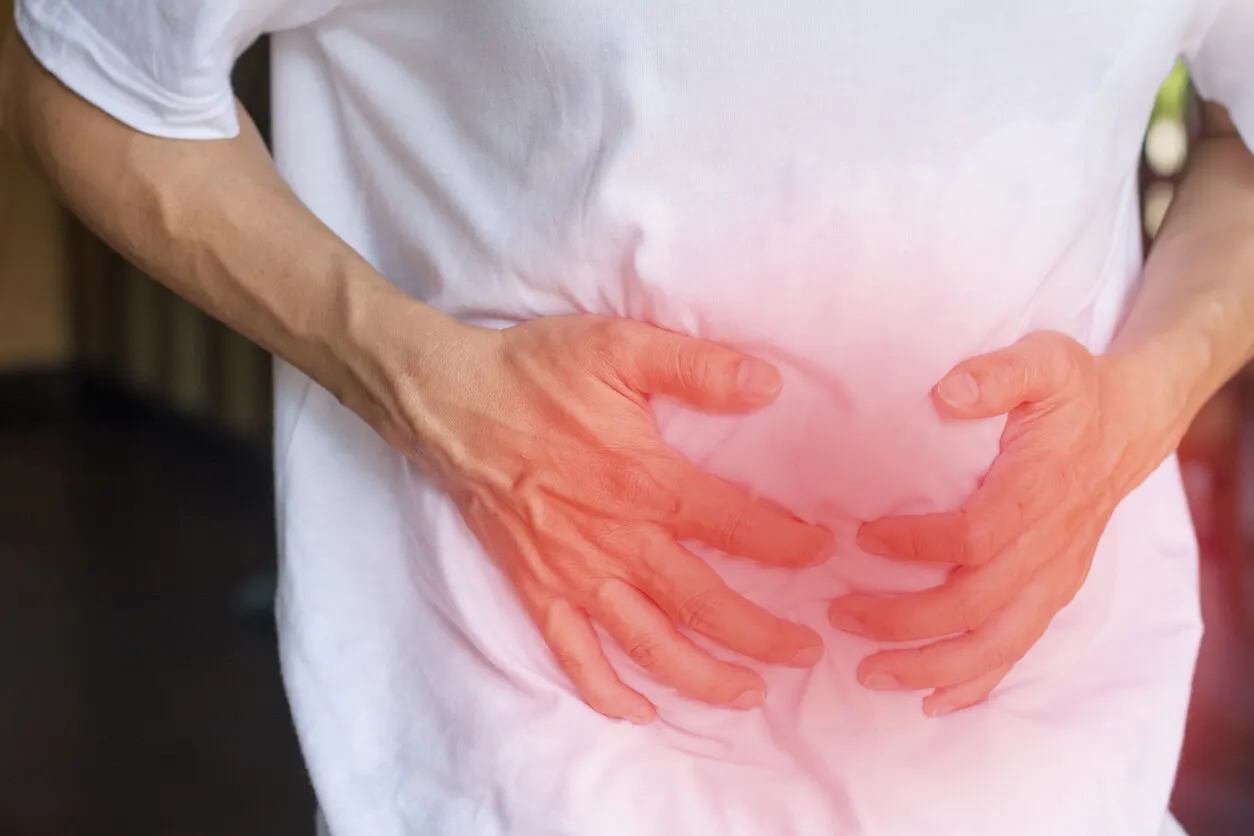Crohn's Disease: Types and Management Tips

Did you know that there are several types of Crohn’s disease? To begin with, it’s worth remembering that this condition, together with ulcerative colitis, is part of inflammatory bowel disease (IBD), a disorder characterized by chronic inflammation of the gastrointestinal tract.
Today, it’s a common condition in modern, industrialized countries. Studies estimate an incidence of 0.1 to 16 cases per 100,000 inhabitants worldwide. Moreover, it tends to occur in the second and fifth decades of life, especially in males.
In general, it’s an insidious, progressive, and disabling disease, the main symptom of which is diarrhea with or without blood. Early diagnosis and lifestyle changes favor symptom relief and can lead to a better quality of life. Here are its main characteristics.
Why does Crohn’s disease occur?
Today, there’s no specific cause of inflammatory bowel disease (IBD). Researchers suggest that dietary habits, lifestyle, and stress are aggravating factors of the disease, but are not directly responsible for its onset.
Nevertheless, it’s believed that the main cause of Crohn’s disease is a problem in the functioning of the immune system. Research suggests that it’s caused by a disproportionate immune response of the intestinal mucosa to an environmental stimulus in a genetically susceptible person.
Enteropathogens, such as bacteria and viruses, usually provide the triggering stimulus for the abnormal response.

Common symptoms
Crohn’s disease (CD) is characterized by an inflammatory process involving the entire thickness of the intestinal wall in an asymmetric, segmental fashion. It can occur throughout the entire digestive tract, although it’s most common in the terminal ileum and colon.
Symptoms vary according to the gastrointestinal segment affected and the severity of the clinical picture. Some of the most common manifestations are the following:
- Diarrhea
- Blood in the stool
- Abdominal pain
- Loss of weight and appetite
- Anemia
- Fever
- Asthenia and weakness
Similarly, extraintestinal signs, such as joint problems and red-eye, common in colonic CD, may be present. In most cases, symptoms appear for 4 to 6 weeks, with periods of remission and exacerbation of the disease.
We think you may be interested in reading this, too: What Are Pro-Inflammatory Foods and What Are The Risks?
The 5 types of Crohn’s disease
In general, Crohn’s disease is classified into 5 types according to their location in the gastrointestinal tract. Each group is associated with different symptoms as well as a higher or lower risk of long-term complications.
1. Crohn’s disease: Ileitis
This occurs at the level of the terminal ileum, the final part of the small intestine. This type of CD occurs in 10 to 30% of affected individuals, according to studies. In general, it’s characterized by the appearance of cramping and discomfort in the lower right quadrant of the abdomen and above the groin. In addition, persistent diarrhea is common.
Crohn’s disease at the level of the ileum can be complicated by strictures and intestinal fistulas. Strictures are frequent and are caused by an abnormal reduction in intestinal diameter due to inflammation or scarring of the mucosa. On the other hand, Fistulas are channels that communicate the intestine with other structures and increase the risk of sepsis.
2. Crohn’s disease: Colitis
Crohn’s colitis is called “granulomatous colitis.” This involves one or more regions of the colon, without affecting the small intestine. It’s the second most common type of Crohn’s disease and occurs in 20 to 30% of people.
This form is characterized by blood in the stool, weight loss, loss of appetite, fever, joint pain, skin lesions, and eye changes. In addition, individuals may develop perianal disease, as well as fistulous complications and intestinal ulcers.
3. Ileocolitis
This is the most common form of Crohn’s disease and appears in up to 60% of affected persons, according to research. It involves the terminal ileum and some areas of the colon, especially the cecum and ascending colon.
It’s generally characterized by diarrhea, fever, weight loss, and cramping in the lower abdomen. Crohn’s ileocolitis can become complicated by intestinal obstruction, abscesses, and fistulas in the digestive tract.
4. Jejunoileitis
This is a patchy inflammation affecting the ileum and jejunum at the level of the small intestine. This is one of the less frequent types of Crohn’s disease. Cramping in the upper and middle parts after eating, as well as diarrhea, are common. In severe cases, intestinal fistulas may occur.
5. Gastroduodenal Chron’s disease
This is one of the rarest types of CD, affecting one or more areas of the esophagus, stomach, and duodenum. It may occur in combination with any of the above forms.
It’s usually accompanied by continuous and recurrent upper abdominal discomfort. In addition, some people may experience nausea and vomiting if the condition is complicated.
Like this article? You may also like to read: The Benefits of Ginger & Chamomile Tea for Irritable Bowel Syndrome
Forms of Crohn’s disease according to the evolutionary pattern
In addition, this condition can also be classified according to its form of presentation and its behavior. These types of Crohn’s disease are based on the degree of involvement of the intestinal wall and include the following forms:
- Inflammatory: This is the classic and initial pattern of CD in any of its locations. People present bowel swelling and ulcers without strictures or fistulas during this initial phase. In general, the greater the extent of the inflammatory process, the more severe the clinical picture.
- Stenosis: This occurs due to fibrosis and scarring of the intestinal mucosa, which causes narrowing of the lumen of the digestive tract and a decrease in its mobility. This pattern usually presents itself with cramping and cramps in the abdomen, increased bowel sounds, diarrhea, and vomiting. In severe cases, it may lead to intestinal obstruction.
- Perforating: This occurs in the presence of fistulas or abscesses that involve the entire thickness of the intestinal wall. Fistulous channels may appear inside the abdomen or communicate with the skin of the sacrum and perineum. In case of abscesses, there will be intense pain and high fever.

Treatment of Crohn’s disease
Currently, there’s no definitive cure for this digestive disorder. However, it is possible to control its symptoms and reduce the risk of long-term complications. Treatment options range from lifestyle changes to the use of medications and certain surgical procedures.
In this regard, the most commonly used medications for the management of this condition include the following options:
- Anti-inflammatory drugs
- Corticosteroids
- Antibiotics
- Antidiarrheals
- Immunosuppressants
In this way, it’s possible to reduce inflammation and alleviate most symptoms. In addition, the physician may also prescribe dietary supplements in case of nutritional deficiency.
On the other hand, some people may require surgery if medications are not effective. In most cases, surgery involves the removal of the affected part of the intestine. This procedure allows attenuating the symptoms for several years.
Some tips to control Crohn’s disease
People with Crohn’s disease can have a good quality of life and control the intensity of symptoms with some changes in their habits. In this sense, it’s advisable to follow the following tips:
- Follow your doctor’s recommendations in detail.
- Don’t stop medical treatment when your symptoms improve.
- Avoid the consumption of medicines without a prescription.
- Maintain a balanced diet that’s abundant in proteins and vitamins.
- Avoid excessive intake of saturated fats, whole dairy products, foods rich in sugars, and red meat.
- Increase your consumption of probiotic sources, such as natural yogurt and kimchi.
- Practice stress-reducing activities.
- Perform meditation and relaxation exercises, such as yoga.
- Reduce consumption of cigarettes and alcohol.
- Seek support from friends and family.
Timely diagnosis and treatment are key to a better quality of life
As you can see, there are several types of Crohn’s disease that can be identified according to the section of the intestine affected and the symptoms that are present. In this sense, the early approach to the clinical manifestations is fundamental to coping with the disease and avoiding the appearance of serious complications over time.
If you suspect you may have this disease, don’t hesitate to seek professional care. Medical specialists are the only ones qualified to diagnose this condition and provide the best treatment options.
All cited sources were thoroughly reviewed by our team to ensure their quality, reliability, currency, and validity. The bibliography of this article was considered reliable and of academic or scientific accuracy.
- Paredes J, Alosilla P, Vargas H, Junes S, et al. Epidemiología y fenotipo de la enfermedad de Crohn en un hospital de referencia en Lima Perú. Rev. gastroenterol. Perú. 2020; 40(3): 230-237.
- Atreya R, Siegmund B. Location is important: differentiation between ileal and colonic Crohn’s disease. Nat Rev Gastroenterol Hepatol. 2021; 18(1): 544–558.
- Márquez J. Enfermedad de Crohn. Enfoque diagnóstico y terapéutico de las primeras visitas. Rev Col Gastroenterol. 2014; 29(4): 404-416.
- Baumgart D, Sandborn W. Crohn’s disease. The Lancet. 2012; 380(9853):1590-1605.
- Freeman HJ. Natural history and long-term clinical course of Crohn’s disease. World J Gastroenterol. 2014;20(1):31-6.
- Mills SC, von Roon AC, Tekkis PP, Orchard TR. Crohn’s disease. BMJ Clin Evid. 2011 Apr 27;2011:0416.
This text is provided for informational purposes only and does not replace consultation with a professional. If in doubt, consult your specialist.








